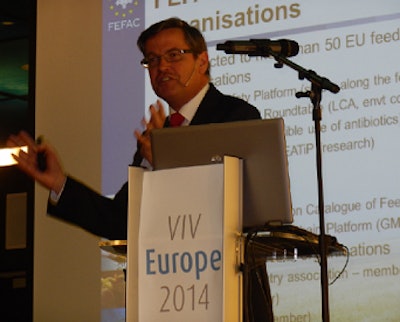
Agriculture is in a time of unprecedented growth potential and unparalleled technology, according to Ruud Tijssens, president of European Feed Manufacturers’ Federation. Speaking May 20 at the opening conference of VIV Europe 2014 in Utrecht, Netherlands, he also said agriculture is facing a new set of challenges while trying to meet the goal of expanding to feed a growing global population. To meet that challenge, the public needs to understand the issues facing modern agriculture.
He used Europe as an example of a highly efficient system of agriculture, but one that is not growing. "We have things like precision farms, NIR, computerized information on feeding and animal health, a lot of new technology that is already being implemented," he said. "But Europe only expects 6 percent growth in animal agriculture. The growth will be in China, India, and South America. We have a highly professional industry in Europe, so why is growth so slow?"
Tijssens said Europe faces the challenge of mixing high-intensity agriculture with a high population density. He said if you compare livestock density and population density, 50 percent of Europe's livestock farming is in densely populated areas. He said farming in intensely populated areas is European agriculture's core competency, but the public doesn't understand that.
As result, he said it can take six to seven years for a farm to get permits for expansion in Northern Europe, and that process is expensive. That is just one factor hindering growth in European agriculture.
"People are moving to the country, then complaining about agricultural activity," said Tijssens. "Our challenge is to figure out how to combine these two activities."
This is not just a problem in Europe. "Look at California in the United States, and you see the same discussion, said Tijssens. "Now GMO labeling is being discussed in the United States. We have to find social acceptance for high-density agriculture."
In addition, Tijssen said the general public is uneasy with modern livestock production methods. "People are disconnected with the reality of modern livestock farming.”
These problems are creating opportunities, as well. He cited slow-growth meat production as an example. "In the Netherlands, 25 percent of the meat production will be slow-growth. This gives producers an opportunity to produce a value-added product. We have to emphasize efficient farming and efficient feeding.”
| EU-27 Production growth, Kt 2013-2022 | ||||||||
| 2013 | 2022 | EU-27 | China | India | Brazil | Russia | World | |
| Poultry meat | 12803,9 | 12976,2 | +1,3% | +18,3% | +30,2% | +15,9% | +26,5% | +18,7% |
| Beef and veal | 7758 | 7957,8 | +2,6% | +16,2% | +21,2% | +10,8% | +20,1% | +13,9% |
| Pig meat | 22400 | 23188,5 | +3,5% | +15,6% | +29,8% | +15,6% | +17,8% | +13,3% |
| Milk production | 154213,6 | 158974,1 | +3,1% | +23,6% | +30,4% | +16,2% | +9,7% | +17,4% |
Source: OECD-FAO Agricultural Outlook 2013-2022

















